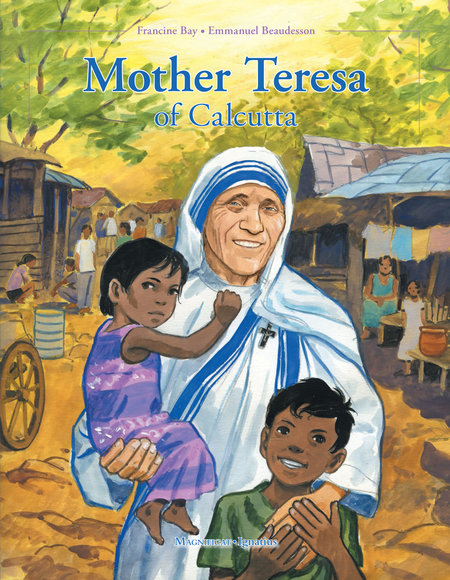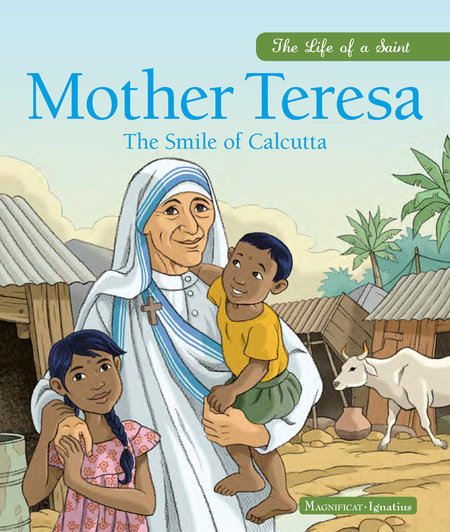Sharing Mother Teresa With Kids Through Good Reads
New books share the saint’s joy with the youngest among us.

It was with shock, a few years ago, that I used the example of Blessed Mother Teresa with a group of fifth-graders and realized … they never saw her in real life.
Well, neither did I, come to think of it. But I saw plenty of news coverage of her. I saw her on magazine covers.
When she died in 1997, I was in my final year of college. I was more aware of the death of Princess Diana than I was of Mother Teresa’s passing.
After all, Mother Teresa was holy. And I was not.
I read about Mother Teresa more after I became Catholic and kept bumping into her writings and wisdom. She became a friend to me somehow, inexplicably and persistently.
I’ve wanted to share about her with my own children, who range in age from 16 months to 11 years, but, frankly, the resources haven’t been abundant.
Pauline Books and Media has an excellent book in their “Encounter the Saints” series that’s a biography: Blessed Teresa of Calcutta: Missionary of Charity (2003). It’s well done and perfect for that series. It’s not something I’ll read aloud, though you could.
Along the same lines, Palest Press has a similar title, Mother Teresa: A Life of Love (1999). This is more of a middle-grade book, appropriate for early-elementary students reading short chapter books, whereas the Pauline title could span older, into late-elementary grades.
I ordered a few books from various publishers online, seeking picture books or anything that could be easily shared. There’s something about a picture book that unites all of my kids. The oldest will deny it, but if the illustrations are engaging and the text is appropriate, she’s as likely to curl up with a younger sibling as she is to read the book herself.
The same, I might add, is true for myself.
When I heard that Ignatius Press and Liguori Publications had titles coming out just in time for Mother Teresa’s canonization on Sept. 4, I was hopeful that I might at last find something that wasn’t manga (a style of Japanese comic books and graphic novels), wasn’t so general as to make Mother Teresa just another big name in history, and wasn’t dismissive of the role her Catholic faith played in her work.
My hopes were realized.
Mother Teresa: A Life of Love (2016, Liguori Publications; shown above) is simply delightful. At first, you may think (as I did) that the illustrations make Mother Teresa too cute, but as the story’s told, the illustrations serve to make her accessible to people who may (like me) find her holiness a bit intimidating, in addition to inspiring.
How can I be holy like Mother Teresa? The beginning of the book makes it clear and inspired me from the very start:
This is the story of a girl named Agnes.
Agnes was very brave. She left her family and home to travel far away. She answered God’s call and became a sister. She gave up what she had to serve poor people in India.
Today, we call her Mother Teresa.
In 61 pages, this soft-cover book tells how Agnes accomplished that, and it even explains the “call within a call” — what has become such a famous part of Mother Teresa’s story in the last few years — in a way that I found easy and accurate.
This book shows the story as much as it tells it. You won’t be ordering prints of these illustrations, but you will treasure them, and it will make reading the book enjoyable in a whole new way. This title is most appropriate for little ones in prekindergarten through second grade, and chances are, the older ones will be able to read it to you (my third-grader had no problem).

There’s a lot of text packed into the 32 pages of book, and it’s going to take an adult or an older child to read it well (the marketing copy says ages 9 and up). That said, this is the kind of book that, if you leave sitting around, will inspire page-turning and narrations, whether or not the exact words are followed.
I appreciated the headings throughout the book, which broke up what could be a rather tiresome story (to a child). For example, explaining one of the keys of the Missionaries of Charity and Mother Teresa’s philosophy, “I thirst,” the book has this to say:
At the same time, the life of the sisters was organized like life in a convent, centered on prayer and service to the poor: “Prayer is the breath of life to our soul; holiness is impossible without it,” Mother Teresa said. The schedule she made for her order included personal prayer, daily Mass, and Eucharistic adoration. And yet, over many long years, she herself secretly lived a Dark Night. Ever since she had moved into the slums, she no longer felt the closeness of Jesus she had before. She felt abandoned by God. She felt the loneliness Jesus experienced on the Cross. But she remained faithful throughout this trial. She continued to pray and to trust in God.
As a constant reminder to the sisters that it was Jesus himself whom they served in the poor, Mother Teresa had the words “I thirst” written on the wall next to the large crucifix in the convent chapel.
All the houses of the order have these words Jesus spoke on the Cross in their chapels.
Slightly smaller in size, and aimed at a slightly younger crowd (ages 5 and up), Mother Teresa: The Smile of Calcutta (2016, Magnificat/Ignatius Press) features illustrations that are lovely, though simpler. The story of Mother’s life is also condensed for the younger audience.

The book begins as an adventure story, and that’s a good reminder to us all.
Land! The boat was about to arrive in Dublin, Ireland. With a lump in her throat, a young Albanian woman gazed at the approaching harbor. At eighteen, Gonxha had bid farewell to her family. She had crossed the whole of Europe to join the Sisters of Loreto!
Another lady passenger also waiting to land said to her, “You’ve come a long way.”
“I hope to go even farther,” Gonxha replied. “My dream is to become a missionary.”
But would the mother superior think her strong enough to be sent to a faraway land? Gonxha was small, thin, and in delicate health. But she had so much trust in God!
From the very first pages, I see opportunities to share the hope and message with my own children. Can you be anything you want? Certainly not. But you can be whatever God has in mind for you!
Let’s not forget that he is the one who planted the desire to be a missionary in young Mother Teresa’s heart, before she ever left her family. There’s a lesson for each of us in these picture books, whether we’re adults or children.
For me, that’s the real power of a good picture book: the ability to transcend the ages of the readers and be an enjoyable experience all around. These books definitely do that, and I’m blessed to be able to share one of my favorite saints with my children through them.
Sarah Reinhard is the co-editor of The Catholic Mom’s Prayer Companion
(Ave Maria Press) and is online at SnoringScholar.com.

















